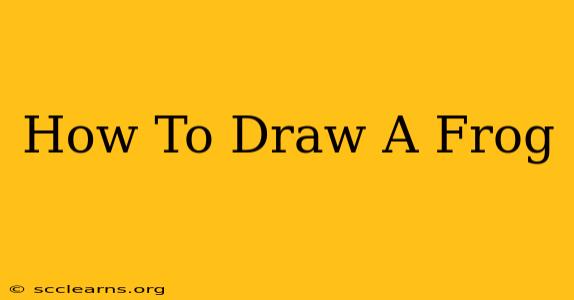So you want to learn how to draw a frog? Fantastic! These amphibious creatures are surprisingly fun and relatively easy to draw, making them a perfect subject for beginners and experienced artists alike. This guide will walk you through several methods, from simple cartoons to more realistic depictions. Let's get started!
Method 1: The Simple Cartoon Frog
This method is perfect for kids or anyone looking for a quick and easy frog drawing.
Step-by-Step Instructions:
- Draw a circle: This will be the frog's head.
- Add two smaller circles: Place these slightly below and to the sides of the larger circle for the frog's eyes.
- Draw two small ovals inside each eye: These are the pupils.
- Add a wide smile: A simple curved line will do.
- Draw a bumpy body: Attach a slightly larger oval or irregular shape to the bottom of the head, leaving a small gap. This is the frog's body.
- Add the legs: Draw four short, stubby legs extending from the body. You can add little webbed feet at the end of each leg for extra detail.
- Color your frog: Use bright, vibrant colors like green, yellow, or even blue!
Method 2: A More Realistic Frog Drawing
This method requires a bit more skill but will result in a more detailed and lifelike frog.
Step-by-Step Instructions:
- Sketch the head: Begin by sketching a slightly elongated oval for the head. Don't press too hard on your pencil, as these are just guidelines.
- Add the eyes: Draw two slightly bulging circles for the eyes, positioned towards the top of the head. Add smaller circles inside for the pupils. Consider adding highlights in the eyes for a more realistic look.
- Shape the body: Draw a broader oval connected to the head, slightly wider than the head. This will be the frog's body.
- Outline the legs: Carefully sketch the front and back legs. The back legs should be longer and more powerful than the front legs. Think about the musculature – frogs have strong legs for jumping!
- Add details: Add webbed toes to the feet, and sketch the texture of the skin. Frogs have bumpy skin, so try to incorporate this texture into your drawing.
- Refine the sketch: Erase unnecessary guidelines and refine the lines of your drawing.
- Add shading and color: This is where your frog truly comes to life! Use shading to create depth and dimension.
Tips for Drawing Frogs
- Observe real frogs: Studying real frogs (pictures or videos) is crucial. Pay attention to their proportions, features, and posture.
- Start with simple shapes: Use basic shapes like circles and ovals as building blocks for your frog drawing.
- Don't be afraid to experiment: Try different styles and techniques until you find one that you enjoy.
- Practice makes perfect: The more you practice, the better you'll become at drawing frogs.
- Use different mediums: Experiment with pencils, charcoal, colored pencils, or even digital art.
Beyond the Basics: Different Frog Species
Once you've mastered the basics, try drawing different types of frogs! Each species has unique features, offering endless drawing possibilities. Research different frog species to find inspiration and challenge yourself. Consider the poison dart frog with its vibrant colors, the tree frog with its sticky toe pads, or even a bullfrog with its impressive size.
This guide provides a foundation for drawing frogs. Remember to have fun, experiment, and keep practicing. Soon you'll be creating amazing frog drawings!

